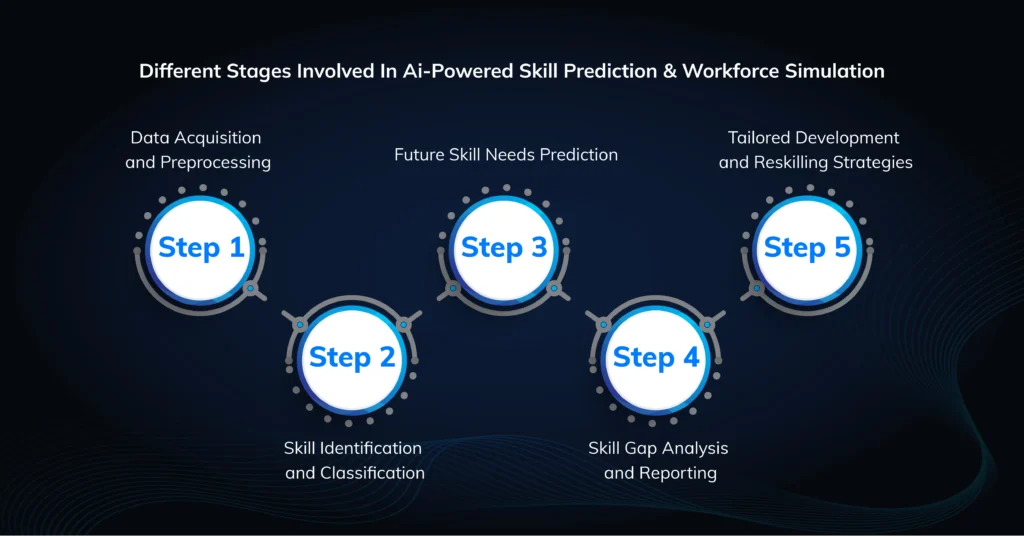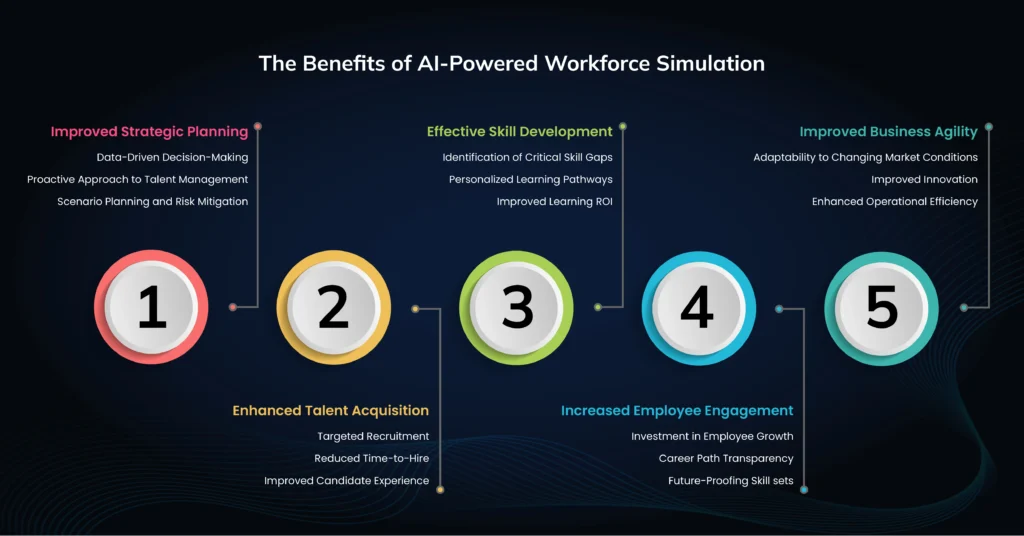In today’s rapidly evolving business environment, staying ahead of the curve requires more than keeping up with current trends. Organizations must anticipate future skill needs to prepare their workforce for the challenges ahead. Leveraging AI-powered workforce simulation is no longer a futuristic concept but a strategic necessity.
By leveraging AI’s unparalleled data analysis capabilities, organizations can glimpse the future, predicting the skills critical for success in the coming years. This foresight allows them to proactively prepare their workforce, closing skill gaps and fostering a culture of continuous learning.
This blog explores how AI can define future job roles and help organizations prepare their workforce for future growth strategies, focusing on Spire.AI’s cutting-edge solutions.
The Challenge: Keeping Pace with Change
Traditional workforce planning methods, which rely on historical data and subjective assessments, must be revised consistently for our fast-paced world. The skills that drove success yesterday may be irrelevant now. New technologies are emerging exponentially, and customer expectations are constantly changing. Organizations must stay ahead of the curve, anticipating future skill needs and ensuring their workforce can handle them.
Critical challenges associated with traditional workforce planning:
– Limited Visibility
– Subjectivity
– Lack of Agility
Here are some of the critical challenges associated with traditional workforce planning methods:
- Limited Visibility: Traditional methods often rely on lagging indicators, providing a limited view of future skill needs.
- Subjectivity: Decisions about future skill requirements can be heavily influenced by individual biases and past experiences.
- Lack of Agility: Adapting traditional plans to rapidly changing market conditions can take time and effort.
The Growing Importance of Predicting Future Skill Needs
As technology advances at an unprecedented pace, the skills required in the workplace are also evolving. Traditional methods of workforce planning, which often rely on historical data and manual updates, need to be revised to meet the dynamic demands of modern businesses. Organizations need a more proactive approach to identify the skills that will be in demand in the future and ensure their employees are equipped with these skills well in time.
Why Future Skill Prediction Matters
- Competitive Advantage: Organizations that can accurately predict and develop future skills gain a significant competitive edge. They are better prepared to innovate and respond to market changes.
- Talent Retention: Companies can improve job satisfaction and retention rates by offering employees opportunities to develop future-relevant skills.
- Operational Efficiency: Proactive skill development reduces the time and cost of recruiting new talent to fill skill gaps.
The Solution: AI-Powered Skill Prediction & Workforce Simulation
AI-powered skill prediction & workforce simulation goes beyond simply identifying future skills. It’s a comprehensive approach that leverages the power of AI to create a dynamic and adaptable talent strategy. Here’s a deeper dive into the different stages involved:
-
Data Acquisition and Preprocessing:
- Internal Data: AI systems process internal data sources like employee skills profiles, performance reviews, and project records. This data helps establish a baseline understanding of the current skillset within the organization.
- External Data: AI scours external sources like industry reports, job postings, educational curriculum changes, and competitor analysis. This external data provides insights into broader industry trends and emerging technologies that could impact future skill requirements.
- Data Cleaning and Normalization: Raw data can be messy and inconsistent. AI algorithms clean and normalize this data, ensuring it’s accurate and usable for analysis.
-
Skill Identification and Classification:
- Large Graph Models (LGMs): AI leverages large graph models (LGMs) to extract skills from text-based data sources such as job descriptions, employee resumes, and online courses.
- Skill Framework Development: AI can be used to develop a hierarchical ontology that categorizes skills into different levels (e.g., primary, intermediate, advanced) and relationships between different skills. This ontology provides a standardized framework for understanding and comparing skillsets.
-
Future Skill Needs Prediction:
- Machine Learning (ML) Algorithms: ML algorithms identify patterns and correlations within the data. These insights help predict future skill requirements based on industry trends, technological advancements, and anticipated market shifts.
- Scenario Planning: AI can be used to simulate different future scenarios, allowing organizations to test the impact of various factors on their skill needs. For instance, an organization might simulate the effect of automation on different job functions.
-
Skill Gap Analysis and Reporting:
- Comparative Analysis: AI compares the predicted future skill needs against the current skillset of the workforce, highlighting any potential skill gaps.
- Visualizations and Reporting: AI can generate precise and concise reports with visualizations that showcase the skill gaps, allowing for accessible communication and decision-making across organizational leadership.
-
Tailored Development and Reskilling Strategies:
- Personalized Learning Recommendations: AI can recommend customized learning pathways based on individual skill gaps for employees. This could include online courses, instructor-led training, or mentorship programs.
- Skill Development Budgeting: AI can help optimize training budgets by prioritizing upskilling and reskilling programs that address the most critical skill gaps.
- Internal Mobility Programs: AI can identify employees with transferable skills who might be well-suited for future roles, promoting internal mobility and reducing reliance on external recruitment.
The Benefits of AI-Powered Workforce Simulation
In today’s rapidly evolving business landscape, AI-powered workforce simulation offers many advantages for organizations seeking to build a future-proof workforce. Here’s a deeper exploration of the key benefits:
1. Improved Strategic Planning:
Data-Driven Decision-Making: Traditional workforce planning often relies on intuition and historical data, leading to inaccurate predictions. AI-powered simulation, however, leverages vast amounts of real-time and future-oriented data, enabling organizations to make data-driven decisions about their talent pipeline. This foresight allows them to align their talent strategy with their overall business objectives and ensure they have the right skills to achieve their strategic goals.
Proactive Approach to Talent Management: Organizations can proactively address potential skill gaps before they become critical issues by anticipating future skill needs. This allows them to develop targeted talent acquisition strategies, invest in upskilling and reskilling programs, and attract top talent with the skills needed for future success.
Scenario Planning and Risk Mitigation: AI simulations can model different future scenarios, such as the impact of technological disruption or regulation changes. This allows organizations to test the effect of these scenarios on their workforce and develop contingency plans to mitigate potential risks.
2. Enhanced Talent Acquisition:
Targeted Recruitment: AI can analyze future skill needs and match them against available talent pools. This allows organizations to target their recruitment efforts more effectively, attracting candidates with the specific skills they need to succeed in the future.
Reduced Time-to-Hire: Organizations can create more targeted job descriptions and streamline the recruitment process by identifying the skills required for future roles. This can significantly reduce the time it takes to hire qualified candidates.
Improved Candidate Experience: AI can personalize the candidate experience by recommending relevant job opportunities based on their skills and career aspirations. This creates a more positive candidate experience, which can help attract and retain top talent.
3. Effective Skill Development:
Identification of Critical Skill Gaps: AI-powered workforce simulation helps pinpoint the most critical skill gaps within the organization. This allows them to prioritize their upskilling and reskilling efforts and focus their resources on developing the skills that will significantly impact their future success.
Personalized Learning Pathways: AI can analyze employee skill profiles and recommend customized learning pathways that address their skill gaps. This ensures that employees receive the training they need to stay relevant and competitive.
Improved Learning ROI: By focusing on the most critical skills and tailoring learning programs to individual needs, AI-powered workforce simulation can help organizations maximize the return on their investment in training and development.
4. Increased Employee Engagement:
Investment in Employee Growth: When employees see that their organization is invested in their development by providing them with opportunities to upskill and reskill, it fosters a sense of engagement and loyalty. This can increase productivity, improve morale, and reduce employee turnover.
Career Path Transparency: AI can help employees understand the skills they need to develop to progress within the organization. This transparency empowers employees to take ownership of their career development and chart a clear path for their future success.
Future-Proofing Skillsets: AI helps employees stay ahead of the curve by equipping them with the skills they need to thrive in the future of work. This can give employees a sense of security and confidence in their long-term employability.
5. Improved Business Agility:
Adaptability to Changing Market Conditions: By anticipating future skill needs, organizations can adapt their workforce strategy more quickly and effectively to changing market conditions. This allows them to seize new opportunities and stay ahead of the competition.
Improved Innovation: A future-proof workforce with the right skills is better positioned to drive innovation and develop new products and services. This can give organizations a significant competitive advantage in the marketplace.
Enhanced Operational Efficiency: AI-powered workforce simulation can help organizations optimize their workforce by ensuring they have the right people with the right skills in the right roles. This can lead to improved operational efficiency and increased productivity.
The Role of Spire.AI in Building the Future Workforce
Spire.AI is a leading provider of AI-powered talent management solutions that empower organizations to build future-proof workforces. Their solutions focus on three key areas:
- Skill Management: Spire.AI’s Auto-Evolving Role-Skill Framework utilizes a large graph model (LGM) to identify complex skill mixes for every role, creating a single source of truth for skills and role data. This framework helps organizations understand their current skill landscape and identify areas for development.
- Talent Development: Spire.AI aggregates data from various sources to build AI-generated employee skill profiles. Based on these profiles, the system can recommend personalized learning paths to help employees upskill or reskill for future roles.
- Talent Mobility: Spire.AI facilitates internal mobility by creating a talent marketplace that matches employee skills with open positions within the organization. This helps organizations leverage their talent pool and reduce reliance on external recruitment.
By utilizing these solutions, organizations can clearly understand their future skill needs and develop a comprehensive strategy for preparing their workforce for success.
Conclusion
In an era of rapid technological change, predicting future skill needs and preparing the workforce accordingly is crucial for organizational success. AI offers powerful tools to anticipate these needs, map current skills, and create personalized employee development plans.
Spire.AI’s innovative solutions provide a comprehensive approach to AI-driven workforce planning, helping organizations stay ahead of the curve and achieve their strategic goals.
By embracing AI, organizations can ensure they have the right skills to navigate future challenges and seize opportunities, ultimately driving growth and success in an increasingly complex business landscape.








